Day 1 of a three day Early Autumn Tour today. It was a grey and drizzly start, but although it brightened up during the morning, another band of heavy showers passed through quickly in the afternoon. Still, we successfully managed to dodge the rain, and had a great day, notching up a surprisingly long list despite the weather.
To start the day, we popped down to Wells. As we got out of the minibus, a juvenile Marsh Harrier drifted across the fields, chased by a Kestrel. Looking across to the pools, we could see lines of Black-tailed Godwits flying up and heading off inland to feed. A flock of Ruff flew up with one group of godwits too.
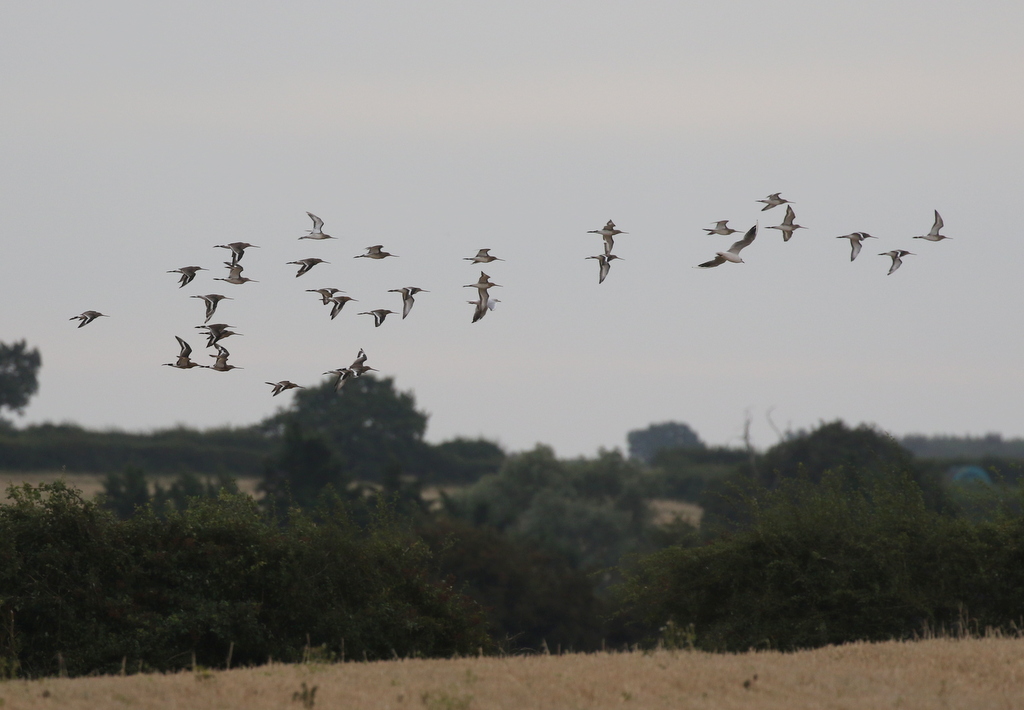
We set up the scope and started to scan the pools, there were still lots of Black-tailed Godwits on the edge of the water and a lone Common Snipe probing busily in the mud. Otherwise, the pools were dominated by the geese – lots of Greylags, and a small group of Canada Geese. Ten Barnacle Geese were unusual here, but most likely feral birds, possibly from the small population at Holkham or even further afield. The Egyptian Geese numbered a substantial 38 today.
There were lots of ducks too, though all in drab plumage at this time of year. As well as plenty of Teal and Shoveler, we could see lots of Wigeon around the edges of the pool today. Numbers are increasing steadily now as birds return from Russia for the winter. One small duck stood out, puddling on the mud at the back. With its strongly marked face pattern, brighter supercilium and white spot at the base of the bill, it was a Garganey. A nice bonus.
Walking down the track, there were one or two Reed Buntings still in the bushes. A flock of Linnets circled over out in the middle and came down to bathe in one of the shallow pools. A Yellowhammer flew over calling. A lone Green Sandpiper was feeding on the mud on the other side of the track.
Their yelping calls alerted us to four Pink-footed Geese which circled and dropped in on the mud with the other geese. Through the scope, we could see their dark heads, delicate bills and the pink band on the bill of the adults, though it was much duller on the single juvenile with them. They have just started to return from Iceland in the last few days, a sure sign that Autumn is definitely here!
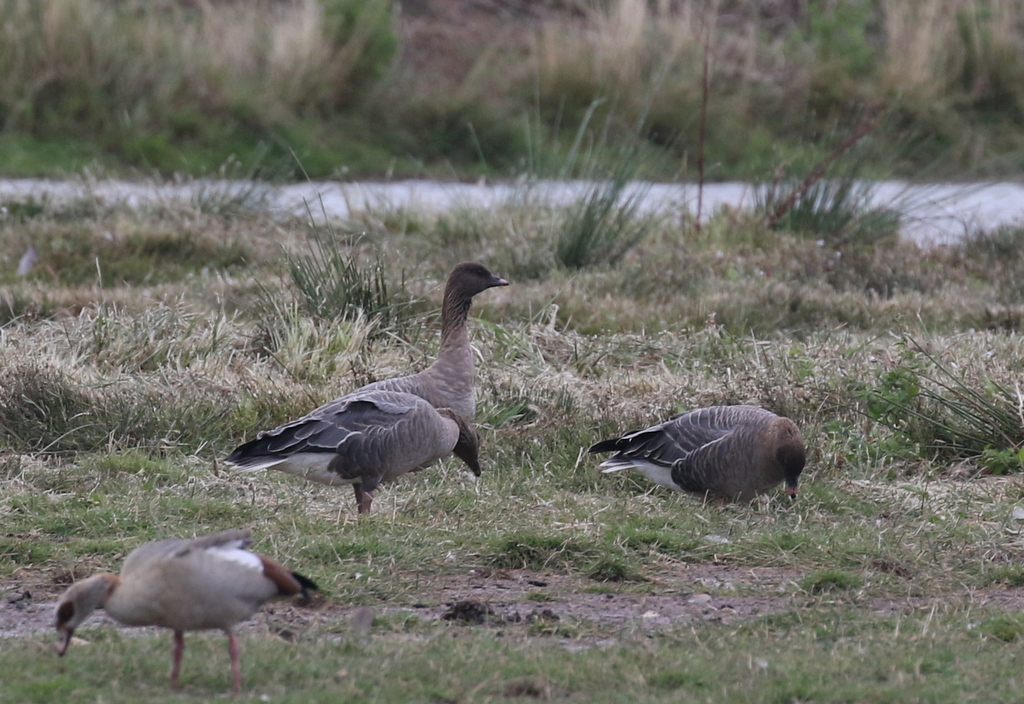
A distant Red Kite was hanging in the air way off to the east. We had planned to have a walk round the bushes further down the track, but we could see dark clouds approaching from the west, so we decided to head back to minibus. It started to spit with rain, so we were glad we did.
We had planned to head over to the Wash this morning and we drove through some rain as we made our way there. The tide would not be big enough to push all the waders off the mud today, but would still come in enough to bring some of them close enough for us to see them.
As we got up onto the seawall at Snettisham, the rain had stopped. The tide was coming in steadily but there was still lots of exposed mud, and it was possible that the blustery SW wind was holding back the water somewhat. There were lots of waders on the mud over by the sailing club, so we walked back the other way along the seawall.
A large flock of Oystercatchers was roosting on the mud, looking like a black slick. There were several little groups of Golden Plover hunched down in amongst the clods of mud, remarkably well camouflaged despite their golden speckled upperparts. Lots of Knot were sleeping on the mud too and equally well hidden until they moved. From time to time the birds would lift and fly round, at which point we could see just how many were really there.

There were some much closer Knot feeding just below the seawall and we had a closer look at them through the scope. They were all juveniles, some rather grey but others with a much stronger orangey wash on the breast. Scanning the mud and the sand beyond, we found good numbers of Ringed Plovers and one or two Dunlin. A little flock of Sanderling running round on the sand then flew off past us, higher up the shore. There were a few Turnstones too, including one still in bright breeding plumage, with orange-chestnut stripes in its upperparts.
Along the shore, there were lots of Black-tailed Godwits still feeding. Through the scope, we found a Bar-tailed Godwit with them, still in breeding plumage with its chestnut underparts extending all the way down under its tail. There were more Bar-tailed Godwits on the mud nearby. A colour-ringed Curlew was the same bird we had seen in almost the same spot a few days ago.
A group of Sandwich Terns was loafing on the mud with some Black-headed Gulls. Just as we got close enough to have a good look through them through the scope, the one Mediterranean Gull took off and flew inland past us, an adult flashing its white wing-tips. Several Common Terns flew in round the edge of the Wash and joined the Sandwich Terns.
We could see what looked like clouds of smoke off in the distance, further out round the Wash. On closer inspection, they were huge flocks of Knot. Something had spooked them from the mud and we watched as they whirled round, the flocks changing shape as they twisted and turned in unison.
There were a few Linnets, Goldfinches and Meadow Pipits along the seawall, which flew up ahead of us as we walked along. Little groups of Pied Wagtails were feeding on the mud just below. The hirundines are on the move now, leaving us for the winter. We watched a steady passage of Swallows and House Martins flying past, skimming low over the mud, or up over the seawall behind us, heading south.
It started to spit with rain again, so we made our way down to the hides. A single Greenshank was roosting on its own on the pit before the causeway. There were more waders on the mud on the near edge of the Wash, including several Grey Plovers, still with mostly black faces and bellies yet to finish their moult out of breeding plumage, and one or two closer Bar-tailed Godwits.
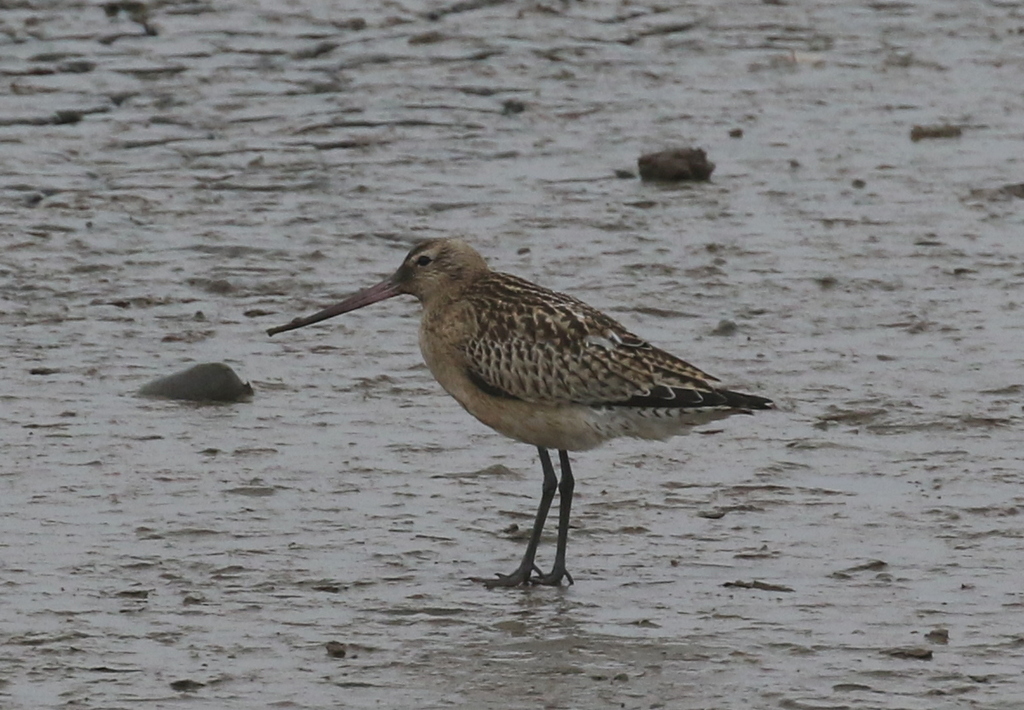
We sheltered in Rotary Hide as a squally shower passed over. Scanning the pit away to the south, we could see several Spoonbills roosting with the Little Egrets tucked in tight along the edge at the far end of the pit. The islands at the north end of the pit were largely empty today as the waders prefer to roost out on the mud unless they are forced in here, but three Spotted Redshanks were sleeping out in the middle in amongst the Greylags. So when the rain stopped, we walked on down to Shore Hide.
Through the scope, we had a much closer view of the Spotted Redshanks from here, but we couldn’t see the Spoonbills from this angle, so we walked on down to South Hide. Two Yellow Wagtails flew over calling and dropped down into the grass, a Skylark came up from beside the path and a Reed Bunting flew up from track and landed in the suaeda just in front of us. A Sparrowhawk shot past, low over the grass, and chased after a Meadow Pipit as it flew up. They twisted and turned for a few seconds, but the pipit managed to evade it and the Sparrowhawk gave up and flew off over the inner seawall.
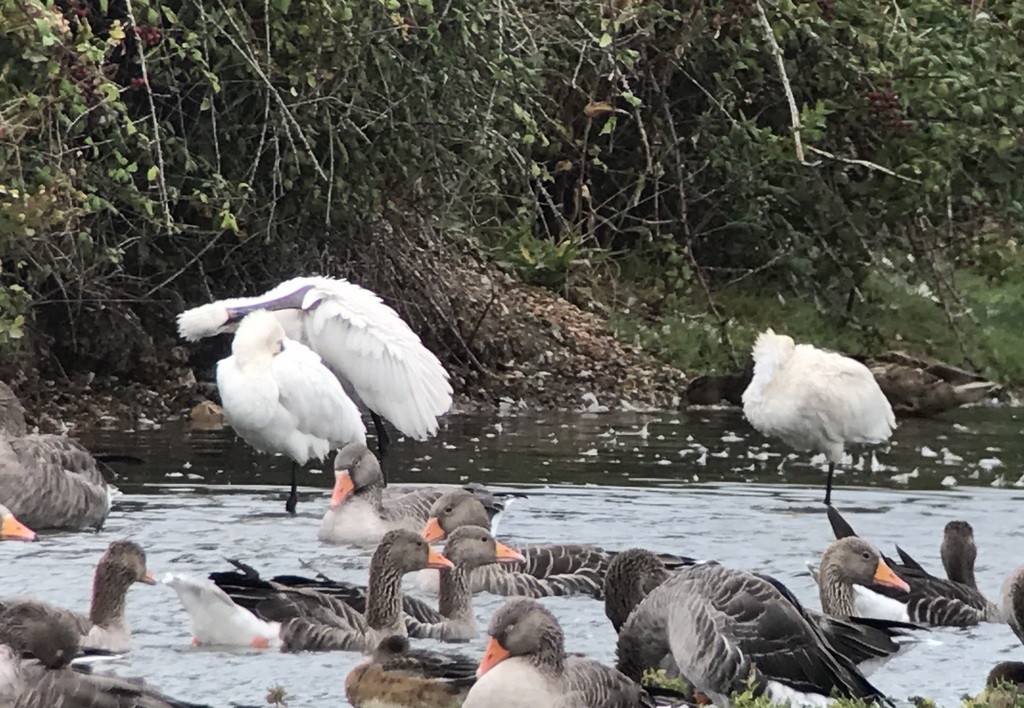
From South Hide, we could now see the three Spoonbills roosting on the edge of the pit. They were mostly asleep – typical Spoonbills – but woke up once or twice to look round or have a quick preen, flashing their distinctive spoon-shaped bills.
There were more waders at this end, mostly Black-tailed Godwits roosting on the islands. A few Knot were huddled together in with them. Three Avocets were still feeding in the water. Something must have disturbed the waders out on the Wash, because we could see some large flocks whirling round over the mud in the distance. Several larger groups of Black-tailed Godwits and Redshanks flew in and streamed down onto the islands to join the birds already here. A few more Knot came in with them, but most still preferred to stay out on the mud.
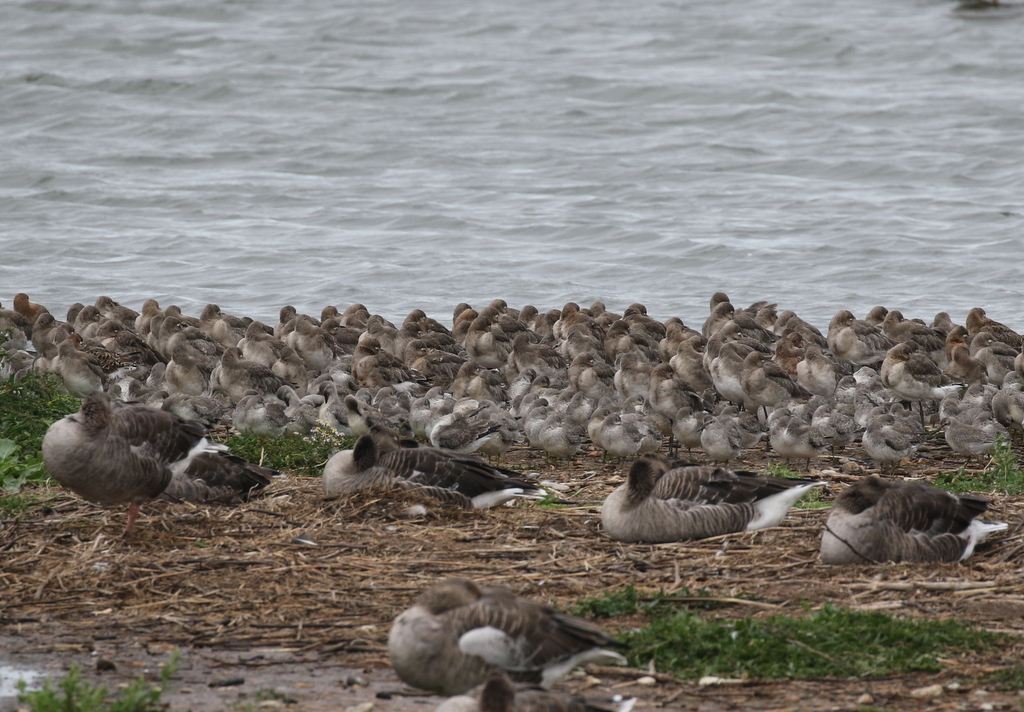
It was getting on for lunch time, so we decided to make our way back. As we walked out towards the Wash, a Marsh Harrier drifted high over and flushed the large flock of Oystercatchers roosting out in middle, which whirled round before resettling. We made our way round to Titchwell for lunch. The sun was out now and we could even sit out on the picnic tables.
After lunch, we walked out onto the reserve. A Chiffchaff was singing in one of the sallows by the main path and we could hear Bearded Tits calling in the reeds, but it was still very windy here and they were not surprisingly keeping their heads down. With the wind, there were few ducks on the reedbed pool today.
We were told that a Curlew Sandpiper was fairly close to the west bank further up along the path, so we walked past Island Hide to scan the mud on the edge of the Freshmarsh. We quickly found the Curlew Sandpiper in with a small group of Dunlin. It was a juvenile, with scaly patterned back and peachy-buff wash on the breast, slightly bigger, paler and longer-billed than the Dunlin. Three more Curlew Sandpipers were feeding further back, all juveniles too. Amazing to think that they were raised in Central Siberia this summer and are making their way down to Africa for the winter.

The sun was shining here but we could see some ominous grey clouds away to the west, more rain coming our way. We walked back to Island Hide. Two Ringed Plovers were feeding on the mud just outside the hide, and a single Little Ringed Plover was with them. It was noticeably smaller and differently shaped. A juvenile, we could make out a ghosting of the distinctive golden yellow eye ring shown by the adults.
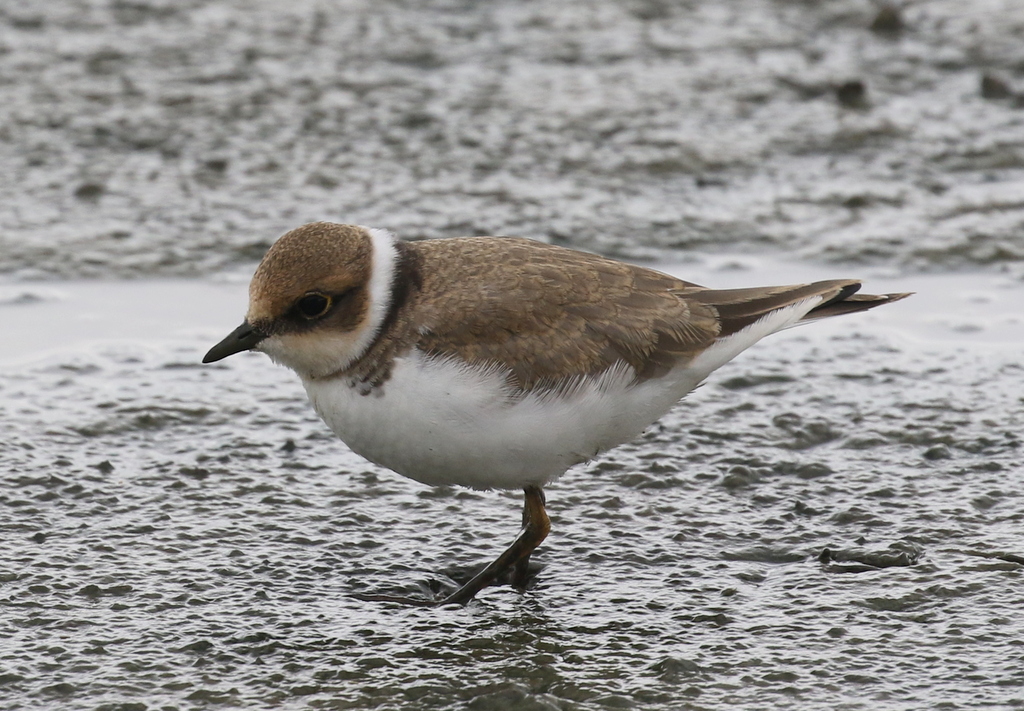
There were lots of Ruff out on the mud, a confusing mixture of paler adults and browner juveniles, the former with brighter orange legs and the latter with duller yellow-flesh legs, the large males and much smaller females. A single Common Snipe was on the mud over by the reeds.
Two Bearded Tits were feeding on the edge of the reeds, hopping about out on the mud. We had a good view in the scope, both tawny brown juveniles. Later another group of Bearded Tits appeared low down in the reeds a bit further back, including a male with powder blue head and black moustache. A smart male Marsh Harrier flew across low over the reedbed, its grey wing panels catching the sunshine.
A Water Rail appeared out of the reeds to the right of the hide next. We watched it as it worked it’s way along the edge, in and out of the reeds, then came right came out into the open in the deeper water in the small channel between the islands.

The cloud arrived and it started to rain, quickly turning heavy. The birds all stopped feeding and turned into the rain. Some lifted their heads, and pointed their bills up to let the water flow off as they were battered with raindrops. Some sought shelter, hiding behind the tufts of vegetation. It was interesting to watch how the different birds reacted to the weather. A Common Sandpiper appeared on edge of island out in middle.
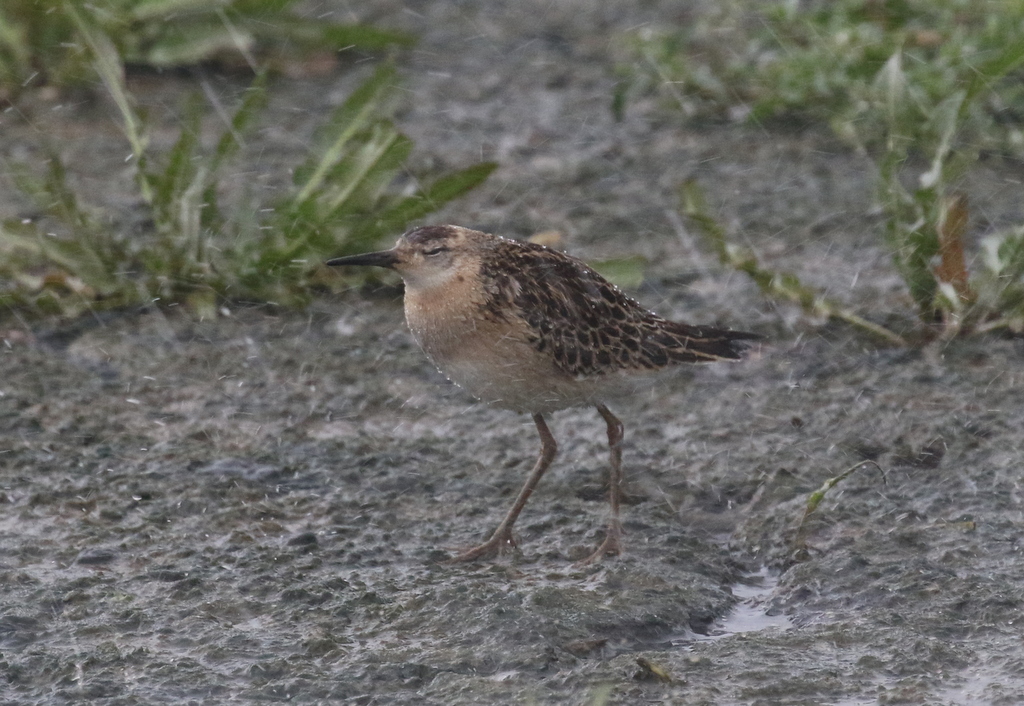
The rain quickly eased off, and all waders started feeding again. Lots had sought shelter on the mud on the edge of the reeds and there were now lots of Ruff and Dunlin gathered there. The Avocets had come over to the edge too from where they had been feeding or roosting further back, and stood preening now, trying to dry off.
It continued to drizzle on and off for a bit, so we stayed in the hide in the dry. When it finally stopped, the sun came out and it was suddenly back to blue skies. We decided to head round to Patsy’s. As we walked back along the main path, a small skein of 27 Pink-footed Geese flew over the visitor centre, calling, heading west. More birds arriving back from Iceland.
There were several Blackcaps calling in the trees behind Fen Hide and Blue Tits and Goldfinches feeding in the brambles by Tank Road. A flock of Long-tailed Tits made its way quickly along the hedge. We looked up in the trees to see if the Turtle Doves might be there drying themselves out, but there were just a couple of Woodpigeons today.
There were lots of ducks on Patsy’s Reedbed, including Gadwall, Tufted Duck and Common Pochard, all additions to the day’s list. There were several Little Grebes scattered round the pool too. We sat in the sunshine for a while. Several House Martins were flying round over the reeds and dipping down to the water. A Lesser Whitethroat appeared in the hedge behind us, but was quickly chased off by a second Lesser Whitethroat.
It was time to head back now. As we got back to the minibus and were just loading up, we looked up to see a Turtle Dove fly across car park and land in the trees at the back, with the Woodpigeons. We got the scope out again and watched it preening in the sunshine. We could see the rusty fringed feathers on its upperparts and black and white striped patch on the side of its neck.

With the UK population having declined by more than 90%, it is always a treat to see a Turtle Dove these days. This one will soon be leaving us, heading off to Africa for the winter, running the gauntlet of the guns in France and Spain, which still allow the shooting of Turtle Doves despite their precipitous decline. We just hope it will make it back again here next year.
It was a great way to end the day, with a Turtle Dove, but always a sobering thought that one year they may not return.
















